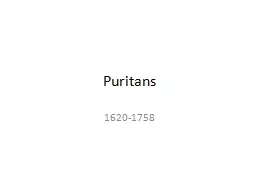

16201758 Literature in Early America Early colonists did not call themselves Americans until the mid 18 th century Roanoke Island 1580 Jamestown 1607 Pilgrims landed at Plymouth 1620 ID: 376805
Download Presentation The PPT/PDF document "Puritans" is the property of its rightful owner. Permission is granted to download and print the materials on this web site for personal, non-commercial use only, and to display it on your personal computer provided you do not modify the materials and that you retain all copyright notices contained in the materials. By downloading content from our website, you accept the terms of this agreement.
Slide1
Puritans
1620-1758Slide2
Literature in Early America
Early colonists did not call themselves “Americans” until the mid 18
th
century
Roanoke Island, 1580
Jamestown, 1607
Pilgrims landed at Plymouth, 1620
Puritans founded Mass Bay Colony, 1630Slide3
Mass Bay Colony
The Puritans were the center of colonial culture
Found Harvard, 1636
First colonial press, 1638
First American published book, 1640
First colonial newspaper, 1690Slide4
Puritan Beliefs
Doctrine of the Original Depravity
Adam and Eve broke the covenant with God
All people were sinners and damned
Doctrine of the Elect
Predestination – only a select few would go to heaven
All sinners must live a holy life – you never knew
Being good would not change your damnation
Slide5
Puritan Concepts
Supremacy of Divine Will
Natural phenomena is the will of God
Un-natural events caused by the Devil’s witches
Theocracy
Government controlled by the church
The DevilSlide6
Puritan Values
Education – created America’s first schools
Hard Work
Family Life
Community Service
Self-sacrifice
The forest is evil and home to the DevilSlide7
Characteristics of Puritan Writing
The Bible provided a model for Puritan writing – each individual life was a journey to salvation.
They saw a direct connection between Biblical events (allusions) and their own lives.Slide8
They used writing to explore the inner and outer lives for signs of the workings of God.
Diaries and histories were the most common types of literature.
They favored a “plain style” similar to that of the Geneva Bible and stressed clear expressions over complicated figures of speech.
Characteristics of Puritan WritingSlide9
William Bradford
1590-1657
Of Plymouth Plantation
Described hardships of journey to New World; unshakeable belief in God.
Plain Style of writing - few figures of speech or metaphors.Slide10
Mary Rowlandson
1636-1678
A Narrative of Captivity
Story of capture by Native Americans; endured many hardships
Saw her story as reflection of Bible stories of hardship- used allusions to Biblical stories.Slide11
Anne Bradstreet
1612-1672
The Tenth Muse Lately Sprung Up in America…By a Gentlewoman in Those Parts
Published in England without her knowledge.
Explores religion and personal relationship with God.
Difference - Use of metaphor in writing.Slide12
Edward Taylor
1642-1729
The Poetical Works of Edward Taylor
Differed from other Puritan writers - use of metaphor in writing.
Explored how his identity was shaped by “God’s Grace”.Slide13
Huswifery by Edward Taylor
Make me, O Lord, thy Spinning Wheel complete.
Thy Holy Word my Distaff make for me.
Make mine Affections thy Swift Fliers neat
And make my Soul thy holy Spool to be.
My Conversation make to be thy Reel
And reel the yarn thereon spun of thy Wheel.
Slide14
Analysis of “Huswifery”
Examines personal relationship with God.
Shows belief in God’s “grace” and rebirth as a “saint” here on earth.
Differences: Use of metaphor to compare life and self to weaving and spinning wheel - avoids the “plain style.”Slide15
Jonathan Edwards
1703-1758
Fire and brimstone imagery.
Helped bring about the Great Awakening.
Tyrannical pastor - extreme and strict - humans “lowly sinners.”
The last Puritan
(
Elements of Literature, Fifth Course, 77
).Slide16
Works Cited
Dolan, Jennifer.
Puritan Literature in America.
Henry County Schools, McDonaugh, GA. 2001. PPT.